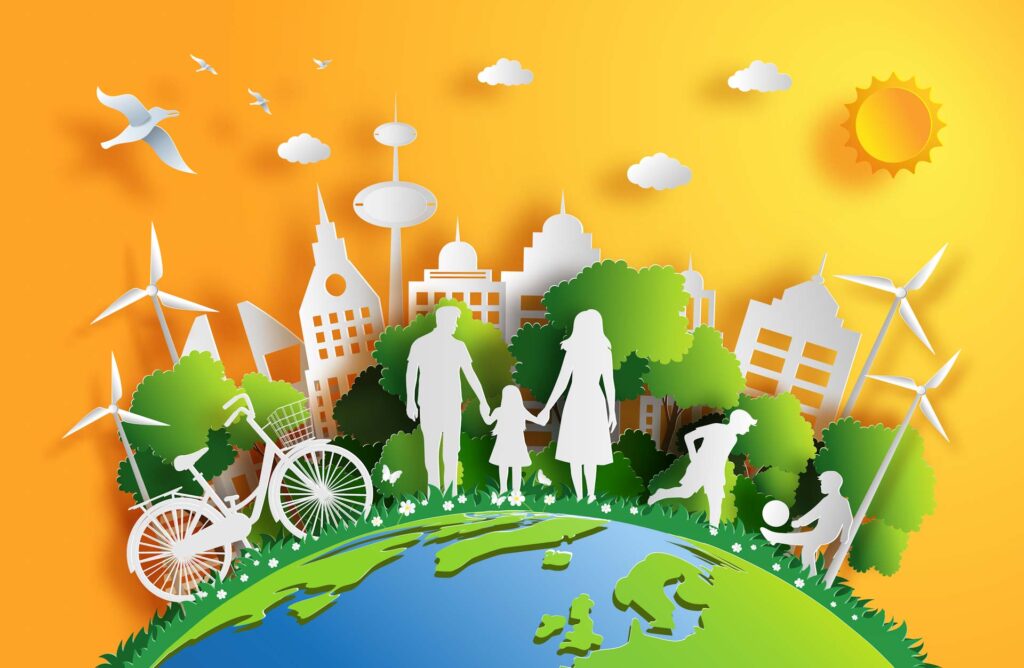
Some of the most compelling images from countries and nations that were locked down during the COVID-19 pandemic — apart from the eerily empty streets, highways and public spaces — were pictures of the Earth starting to heal. Crystal clear skies, waterways and oceans replaced polluted air, rivers and seas. Even the animals rejoiced and frolicked!
If we learned nothing else from the pandemic, it was that human activity, particularly the use of personal motor vehicles, is directly responsible for climate change. But we knew that already, right? Why did we need a pandemic to remind us of the glaringly obvious? Le sigh.
With those of us who could working from home and (mostly) loving it, that trend is likely to continue. As the world gradually eases lockdowns and things slowly return to normal — albeit a new normal in many cases — it is clear that physical distancing is having a positive effect on the planet. Working remotely from home has taken millions of cars off the road, saved on fuel costs and given workers back one of the most precious commodities of all: time.
Millions of cars… off the road
It might seem obvious, but when you have millions of motor vehicles on roads and rails commuting to the office, you have millions of tons of carbon dioxide (CO2), as well as other pollutants, being released into the atmosphere. And we know that CO2 is a major factor when it comes to climate change because it’s a greenhouse gas (GHG) and greenhouse gases trap heat, which causes global warming.
According to the United States government’s EPA website, a single passenger vehicle typically releases about 4.6 metric tons of carbon dioxide annually. As you can imagine, the office commute is a significant contributor to that number.
In the European Union, the story’s not much better, with road transport accounting for 72% of all CO2 emissions, and personal transport making up almost 60% of that 72%. And in Australia, where owning a car is almost a necessity because of the distances that need to be travelled, private motor vehicles contribute around 3.75 tons (4.13 tons) of GHG per vehicle annually.
South-East Asia, not generally known for its policies on environment and sustainability, has a growing middle class which, unfortunately, translates to more cars on the road. In Vietnam, one of the fastest growing economies in the region, carbon emissions from road transport will increase 4.5% annually, reaching 126 million tons by 2020. That’s of course, if nothing is done.
But ASEAN is small fry when compared with the top ten emitters: US, China, Russia, India, Brazil, Japan, Canada, Mexico and Iran, who in 2014, accounted for 53% of transport emissions. Not good, right?
Tanking on it
Of course, we’re aware that not everyone cares about their contribution to greenhouse gases when they hop in their car to go to work. People like convenience, and who can blame them? The question often is: do you spend two hours on public transport taking a bus and two trains to work, or — assuming, of course, that the roads aren’t congested — a half an hour in a car? Not everyone is altruistic when it comes to helping the environment and reducing their carbon footprint.
What people also care about is their hop pocket, particularly fuel costs, which are on an upward trajectory and have been for decades. Interestingly though, fuel prices went down during the COVID19 pandemic because there was no demand — no one was driving or travelling. This ten year low is short-lived: prices are creeping up again as business as usual takes precedence.
In Australia, you can spend up to $430 per week on transport costs depending on where you live, with a national average spend of around AUD$17,000 annually on just getting around. A huge slab of that is the commute to the office.
Transportation is certainly cheaper in the US, with the average annual costs for fuel coming in at just over US$2000, and total transport costs averaging around US$10,000 according to the US Department of Labor.
Households in the European Union spend 13% of their income on transport — the highest cost after housing. In the United Kingdom, individuals could spend as much as £26 per week on fuel — £1,352 per year.
Without a doubt, fuel and transportation is one of the largest household expenditures after housing costs — and if trends are anything to go by, it is likely to keep increasing. The pandemic forced households to press the reset on transport costs, and their hip pockets thanked them.
Time’s up

Despite podcasts, audiobooks and portable devices giving the illusion of productivity, time is whittled away on the commute to the office. If you are on a train with your laptop going to and from work, the situation is a little better, provided there’s Wi-Fi — unless you’re content to work offline. On trams and buses, it’s often standing room only, so there’s little opportunity to fire off that email, or tweak the morning’s meeting agenda. No wonder people hate it.
Often, workers can spend upwards of a couple of hours per day commuting to work, particularly if they are living in the suburbs — where housing is cheaper — and their office is in the central business district (CBD).
You’re not alone. Americans spend 200 hours per year commuting, according to the US Census Bureau — the equivalent of nine days they aren’t getting paid for. In India, the commute is around 7% of the day. In the UK, the two hours of every working day is eaten up by the commute to work.
And going to the office before the sun rises and returning home when it’s dark is no fun — especially when you have a family. If your boss chews you out because you’re late to work occasionally, time spent on the commute doesn’t sound like a plausible excuse or rationale or being late to that meeting, particularly when the response could well be: Leave home earlier.
This is where making a case for working at home comes in, and thanks to COVID19, is likely to continue. Rather than having to equip offices — particularly kitchens, workspaces and lifts — to comply with the “new normal” of social distancing, it’s easier and cheaper to allow staff to continue to work outside the office, either at home or a café.
If location independent and remote work continues, it’s a win-win for everyone. Staff save time, money and are less stressed. Bosses have a productive, engaged and happy workforce. How can you argue with that?
Saving Money and the Environment: Potential Benefits of Permanent Remote Work

In the April 2020 Traffic Volume Trends report, the US Department of Transportation reported that travel on all roads and streets went down by 39.8%. While the government did not impose a national lockdown, we can still attribute this change to the efforts of certain states in implementing social distancing. According to the latest Gallup Panel Data, comprehensive quarantine policies have forced 62% of Americans to work remotely. With more people off the road, daily CO2 emissions decreased by 17%.
Now, we know that states will eventually ease lockdown restrictions, allowing businesses to return their operations to their offices. Even so, it won’t hurt if we take a look at how much impact permanent remote work can have. Hypothetically speaking, we can expect the following:

In the final quarter of 2019, there were around 279.6 million vehicles on the road across the US. In an ideal world, we’d spare the country 218 megatons of carbon emissions per year and cut down transport costs by $1.1 trillion. Of course, we need to acknowledge the reality that eventually, most businesses in the US will ease back to “normal” operations. Global Workplace Analytics forecasts that around 30% of the workforce will continue working from home multiple days a week. If that estimation translates into reality, we can expect the following:

How Can You Transition to Remote Work with Ease?
It’s clear from the evidence that working from home or remotely is generally of benefit to not only the planet, but also to those who can. Managers can see that out of sight does not necessarily mean out of mind — which has always been a major concern when managing remote staff. Now, we understand that a lot of managers were caught by surprise when lockdown restrictions were imposed in certain US states. Thankfully, there is a tool that can ensure accountability of all staff, from the top down—even when the employees are geographically scattered. Traqq, a user-friendly app that promotes ethical monitoring, is just what you need.
So, what is Traqq?
We’re glad you asked. Traqq is a time tracking application that you install on your computer. The app, which also works offline, sends all kinds of useful data about workplace activities and productivity to your free web account.
- monitor and measure the activity levels of everyone in your organization, from the top down.
- check which apps and websites are being accessed by your staff; know what they are working on
- automatically bill and invoice clients and pay staff
- build custom reports that are tailored to your reporting requirements. (please check the website for exact features you might find the most suitable)
Why would — or should — I use Traqq?
Now, if you’ve been struggling for the past months to keep your operations afloat amidst the lockdown, it’s natural for you to doubt the sustainability of remote work. Well, this is where Traqq comes in.
Business executives consider face-to-face meetings as crucial components of creating profitable bonds partners and keeping productive relationships with co-workers. However, with the right SaaS tools, simulating these in-person meetings have become easier and plausible. Did you know that at an average, a mid-level manager spends around 35% of their time in meetings? The figures can climb as we explore the upper levels of the corporate ladder. Executives can spend around 50% of the week on meetings. A study by Bain and Company discovered that organizations spend around 15% of the work hours on meetings.
We cannot discount the fact that a lot of meetings are indispensable. However, studies show that employees spend around 31 hours per month in unproductive meetings. So, why bother asking them to come to the office when these types of meetings can be done at home? Why let the employees waste time commuting to work when they may end up wasting their time in useless meetings?
Assuming that meetings, which make up 15% of a work week (40 hrs.), can be done at home, we can expect the following:

If there are 261 working days per year, then the average employee spends about .77 hours per day on commute. Assuming that there are 52 work weeks per year, we can derive that 15% of the work hours (or at least a full day) per week can be spent without traveling to the office. In turn, an employee can save around 40.4 hours per year that they would otherwise spend on commuting to work.
The key here is to properly identify the types of meetings that do not need face-to-face interaction. University professors Nicholas Romano, Jr. and Jay Nunamaker, Jr., identified meetings into six categories: staff, information, task force, brainstorming, ceremonial, and others (miscellaneous). Their study illustrated how much hours are spent on these meetings:
Type of meetings

Now, how does Traqq sit in this situation? Well, as we’ve mentioned, you can use this time tracking app to generate tailored reports according to your operational requirements. So, if you’re planning to perform a time and motion study on what types of meetings your employees engage in, you can use Traqq to automate the process. Assuming that about 50% of meetings are considered time wasted, you can use the tool to identify non-essential activities that do not require face-to-face interaction. These can include ceremonial and miscellaneous meetings, as well as a significant percentage of staff meetings and information sharing meetings.
By identifying utterly and border-line unproductive meetings, you’ll know which collaborative activities can be done via a conferencing app. If these meetings do not require face-to-face interactions, then you can have the data to justify working remotely at least once a week.
The Bottom Line
The point of a company using a time tracking app like Traqq is to monitor performance and profitability. If your employees are working remotely, it makes sense to be able to track tasks, particularly if you are managing a complex project with many staff — and many moving parts. At the same time, it also allows you to identify non-essential tasks that wouldn’t require an employee driving or commuting to work.
Meetings make up a fraction of activities that can be done remotely. Of course, there are plenty of other tasks that an employee can complete without driving their car to the office. Traqq can be your partner in identifying these activities to enable remote work that can cut down your company’s operational costs. What’s more, the reporting functionality of this tool ensures you know exactly what’s going on with your project at any given time of day. Your finger is on the pulse, and your staff know exactly what’s going on — for all around accountability.
References:
https://www.businessinsider.com/average-spending-on-commute-how-much-money-2019-7

